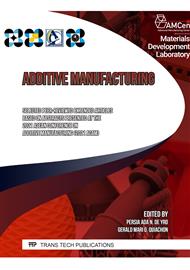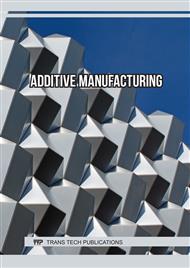p.1
p.13
p.19
p.27
p.35
p.45
Influence of Philippine Halloysite on Thermal and Mechanical Performance of Poly(Lactic Acid) Filament for FDM Printing Applications
Abstract:
Additive manufacturing can be utilized to harness developments in polymer research. This study aims to investigate the effect of Philippine halloysite on poly(lactic acid) (PLA) filament for 3D printing using Fused Deposition Modeling (FDM). PLA-based filaments with halloysite powders were prepared by melt-compounding using a twin-screw extruder. The chemical composition and morphology of the halloysite powder was determined using XRD and SEM, respectively. Composite filament with 3% halloysite (PLA/HSC) was developed and characterized. The thermal properties of pure PLA and PLA/HSC were measured using DSC and TGA. CAD files for XRD analysis and tensile tests were generated using SolidWorks computer software (Dassault Systemes). Printability of pure PLA and the composite filament was observed by using Ultimaker S5 3D printer. The effect on chemical composition and mechanical performance of the 3D printed specimens was evaluated using XRD and UTM, respectively. XRD result confirmed the presence of dehydrated halloysite clay mineral. SEM image revealed the spherical morphology of the halloysite powder with average particle size of 72.472 nm. DSC analysis showed that incorporation of halloysite powder filaments had slightly decreased the glass transition of pure PLA matrix. This could be attributed to the enhanced mobility of polymeric chains by plasticization. Moreover, the melting temperature of PLA/HSC composite has slightly higher value than pure PLA filament owing to increased crystallinity imparted by the halloysite particles. With high stability of halloysite at elevated temperatures, the thermal stability of PLA/HSC filament was also enhanced. Mechanical performance of pure PLA was also improved with addition of halloysite. The tensile strength and elastic modulus of pure PLA matrix increased by 180.32% and 143.96%, respectively which could be due to the formation of hydrogen bonds between PLA matrix and halloysite particles. Digital micrographs of the fractured surface reveal that tensile pieces predominantly ruptured by brittle fracture.
Info:
Periodical:
Pages:
27-34
Citation:
Online since:
February 2023
Keywords:
Price:
Сopyright:
© 2023 Trans Tech Publications Ltd. All Rights Reserved
Share:
Citation:



